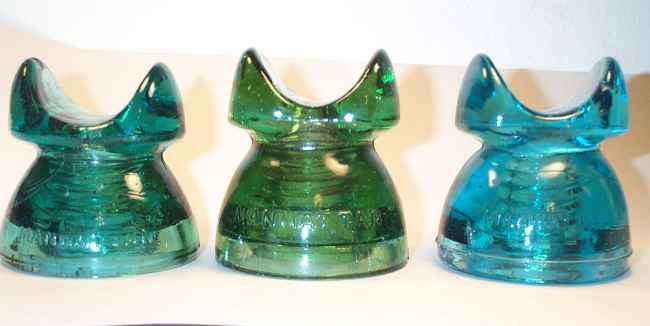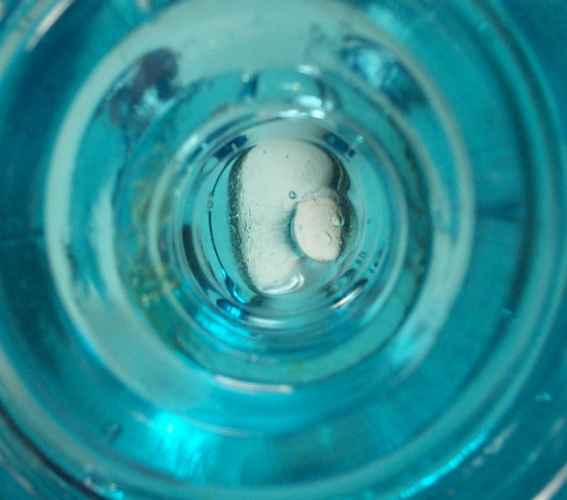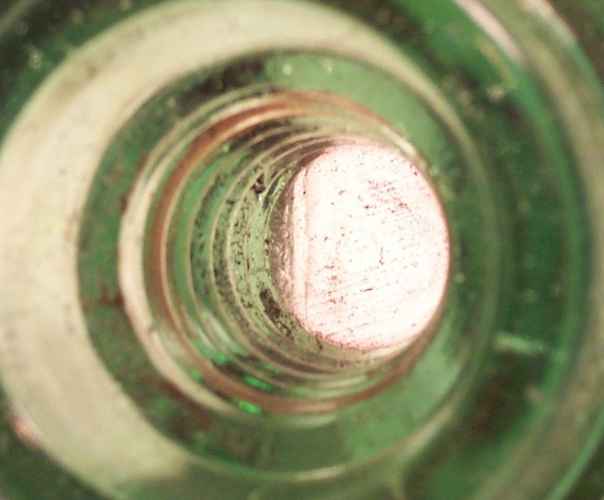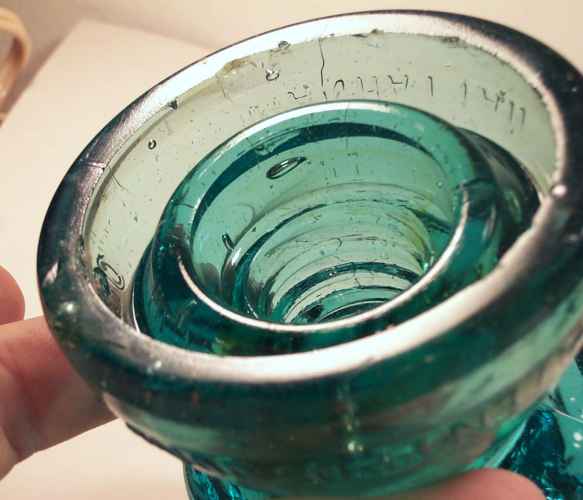
ICON articles extracted from the mailing list
CD 256 Manhattan Insulator Manufacturers
Compiled by Donald R. Briel
8 Nov 2003
Eddie Lewis wondered..
Who made the CD 256 Manhattan insulator? I know the embossing is for Manhattan Electrical Supply, but who produced these? Time frame?
Replies:
Brent Burger comments:
The Manhattans I have looked at bear the mandrel marks of the glass works at Elmer, NJ. This would mean Sterling, Harloe, and Novelty. Novelty was the big green glass maker of the three, and Manhattans do come in greens. I would think that Novelty made many of them, but they may have been sourced elsewhere too.
Paul Greaves comments:
I suspect that there were at least three makers of the CD256 Manhattans, and have posted some pictures to support this conjecture. Evidence gained by digging their dumps could possibly confirm this. More text on this subject can be found under the pictures.
First is a photo of the three insulators:
| Three Manhattans |
 |
| Picture showing three CD 256 Manhattans, I think, made by three glassworks. I suspect (but can't prove) that the left one is Brookfield made, the middle Novelty made, and the right one made by Sterling (or at least the same glassworks that made the Sterlings). Evidence will follow in additional pictures... |
Next is one I suspect was made by Sterling:
| Manhattan #1 |
 |
| I suspect that Sterling made some of the Manhattan insulators... this one is nice relatively clean glass, very blue aqua, and has a characteristic "dimple" up in the pinhole that is often seen in Sterling insulators. This picture shows it (hopefully). I think it is due to the insulator being picked up with a metal rod or tool while still hot, leaving the dimple impression off-center in the dome (about 1/4 inch deep). |
Then one almost certainly of Novelty manufacture (this seems to be the most commonly encountered style):
| Manhattan #2 |
 |
| I suspect that Novelty also made some of the Manhattan insulators... this one is somewhat junky glass, nice yellow green, and has a characteristic "circle" up in the pinhole. This is a feature that is connected with the Novelty glassworks, and is often seen in Knowles, Star, and other insulators. This picture tries to show it (hopefully). It appears to be an artifact of the tooling process used to form the threading mandrel. (I have also seen this style in blue glass, so I suspect that Novelty made some blue glass also.) |
And then finally one I strongly suspect was of Brookfield origin (these seem to be rather scarce):
| Manhattan #3 |
 |
| I suspect that Brookfield made this Manhattan insulator... this one is a typical color for a Brookfield, dark aqua with green streaks, and has a mold line across the base. This is a feature that is connected with a certain time frame of Brookfield production (although not unique to them). This picture tries to show it (hopefully). The inside of the base comes to a very sharp edge, which is typical of this mold style. Interestingly, this mold shows evidence of being modified, as it has an "extension" line running horizontal around the insulator just above the base. It's as if an extra piece of metal was bolted on to the mold and then machined to create the part that would form the base. This makes some sense, as Brookfield won a patent lawsuit against Novelty, and inherited their molds as part of the settlement. It wouldn't take much for Brookfield to determine who the customer for this insulator was, and to offer to continue supplying them... :-) |
Brent Burger comments:
I think Paul Greaves is correct on all points of conjecture. I have never seen one from Brookfield before. The woogly mark you identified on the Sterling-made Manhattan is also found on CD 102's embossed Sterling, Harloe and Star, indicating this condition lasted through the company change at the Upper Works at Elmer, NJ to the Harloe period.
Eddie Lewis comments:
Paul's four pictures answered several personal questions. It confirmed my theory about Brookfield manufacture of some Manhattans and suggested new questions, such as, how many different molds for the CD 256 had a circular indentation in the top of the wire groove about the size of a button? What was the purpose of that indentation...maybe to hold the insulator in place during the molding process? This is not the same indentation as the one in the pinhole rather it is on the outside. Paul Greaves and I noticed that our Sterling type have this outside indentation feature.
Brent Burger comments:
Yes, I have seen the mark in the pinhole inside stars and Harloe's. Here's a question... what is the glass quality on those? The Sterling's always seem clean and not junky. Many of the H-I-Co (Harloe's) ones are a real mess. Maybe, this mark is indicative of the Upper Works at Elmer, before they moved the operation to the state of Pennsylvania. In that case, the glass might be similar to Sterling's.
Here is what we know. There were two "Works" in Elmer, NJ. Three operators made insulators that have been documented. There may have been others making insulators earlier, but this remains nothing more than speculation.
Of the three Elmer operators, two ran one plant, while Novelty worked out of the other. I believe this was the Lower Works, but without checking my notes, do not call it fact, just yet.
All three operators used molds showing the "Elmer ring" at the top of the pinhole. What this was for, in regards to the mandrel, making of the mandrel, or whatever, I have no clue! What I do know is that it is a unique molding characteristic of the three Elmer producers, even though none of the producers had anything in common with each other, beyond Harloe assuming control of the plant AFTER Sterling ceased production.
Now, that funky, broken-mandrel-looking mark I would have thought to be from a mandrel coming apart in use. But I have owned and inspected no less than two dozen of these CD 102's with Sterling, Star, and Harloe markings. I even saw a CD 112 Star with that mark, so it was not limited to CD 102's. This says to me that the condition was going on for some time before the mandrel finally failed, as in so long that it crossed the time between numerous pour set ups, contracts, and company change! The Harloe with the mark that I have has good clarity, for what that is worth.